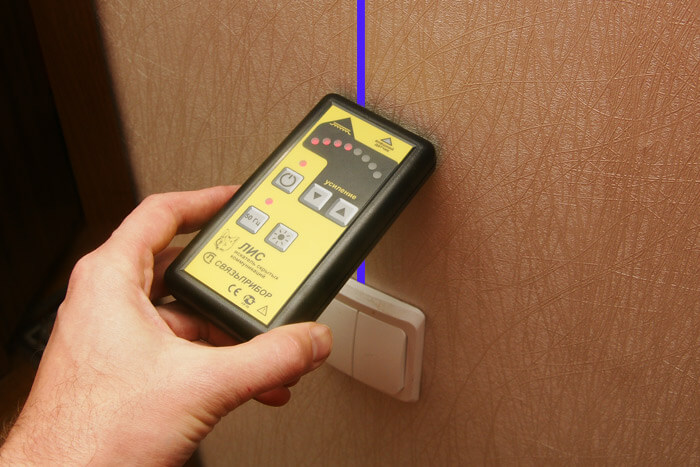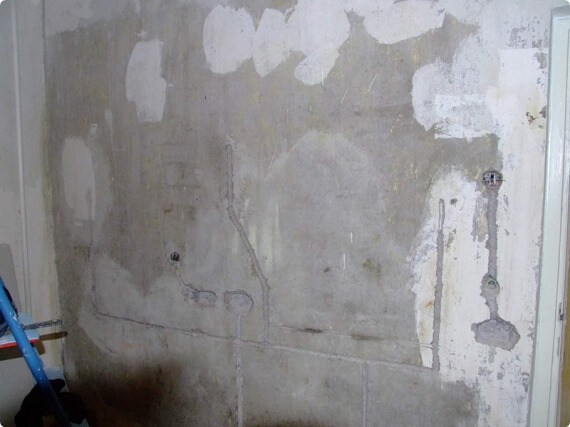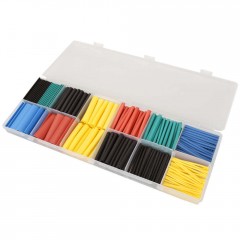How to find a wire in the wall - modern and ancient methods of search
The main reasons for the search
There are many reasons to look for hidden electrical wiring in a concrete wall yourself.
Most often, the problem occurs in such cases:
- Redevelopment of the apartment. For example, you decided to cut a doorway in another place, but do not know where current-carrying conductors pass.
- Open circuit. One of the most painful reasons, because in this case, you will need to not only find the wiring in the wall, but also the place where the zero or phase wire breaks.
- The need to drill a partition. Suddenly you have to connect a wall sconce or hang the tv on the wall.
- Interest in existing communications. If you just bought new housing and have no idea what cable and how it passes through the walls and ceiling, where the junction box is installed, etc.
In all these cases, you can call a wizard who will give you an accurate idea of the power line, or you can try to independently search for wiring in the wall. Do you prefer the second option? Then look further on how to determine the location of the wire under the tile, drywall and other finishes.
Devices to the rescue!
So, if you just need to find the wiring in the apartment, then enough do-it-yourself metal detector. Simple home-made is made from improvised means and will allow you to detect a conductor under voltage up to 10 cm under decorative decoration. On the Internet you can find many schemes by which you can make a simple detector, we provided one of them in the article that we referred to.
If the issue of money is not especially important for you, then it is better to choose a special device for detecting hidden wiring in the wall, which will not only determine with high accuracy where the cable is, but also the exact location of the malfunction if there is a burned out or punctured area. The best in terms of price and quality is a device called the Woodpecker or the E-121 signaling device. Using this detector, you can not only track the exact location of the wiring in the wall, but also find the place where the electrical conductor breaks. The working depth is 7 cm, which is quite enough for amateur use and detection of a tattered core even under a drywall.
Another, no less suitable device for detecting hidden wiring in the wall is the MS alarm. Chinese testers have their own characteristics and features, so you need to get used to them.The problem is that the products react equally to metal parts (for example, a nail), and to a live conductor. To properly operate the tester, you must learn to distinguish signals from each other. That is why professional electricians bypass them, although for home use the option is pretty good. Another important drawback of the devices is that if the cable is protected by a foil screen, it will not be possible to detect it. Such signaling devices have many negative reviews on the Internet, only for the reason that they are difficult to use, otherwise it is a good option for determining electronic wiring.
Also, to detect hidden wiring in the wall, such devices are used as: POSP-1, GVT-92, Bosch DMF 10 zoom, GVD-504A, VP-440. They all worked well for finding a wire break, as well as detecting electrical wiring under the plaster.
I would like to give special attention to thermal imagers. These devices allow you to track not only where the broken core is located, but also to find leakage current, short circuit and the quality of the wiring in the panel house itself. Of course, their cost is prohibitively high, but there is a service to call the master, for which you will give about 2500. In this case, you will be provided with a full report on what the existing power line in the rooms is and whether there is a burnt conductor somewhere.
In addition, you can find out where the wire is in the wall with an indicator screwdriver. This method of searching for wiring is only suitable if the cores are energized shallow in concrete.
Turn on the logic
Any electrician knows that electrical wiring carried out strictly in vertical and horizontal position. In other words, the conductors run parallel and perpendicular to the floor.
 Based on this, one can note the following observations:
Based on this, one can note the following observations:
- Above sockets and switches, the line goes straight up, it is strictly forbidden to drive a nail here.
- Usually a line is drawn at a distance of 15 cm from the ceiling (or floor), here, too, it is not worth conducting various kinds of work.
- Based on all the installed electrical points, you can visually present a picture and sketch where the wire is in the wall.
We draw your attention to the fact that such visual representations are an extremely unsafe option. All your sketches on paper will have to be confirmed at least by a metal detector made by yourself, but it is better to use special devices and indicators.
Grandfather Methods
Of course, earlier, to detect wiring in the wall, they did without appliances, while safely finding the entire power line under wallpaper, tile and plaster. How did our grandfathers and great-grandfathers do this?
We bring to your attention the three most simple options that will allow you to find the wiring yourself:
- If major repairs are planned. Tear off the wallpaper and inspect the wall in Khrushchev (or in the house). Typically, the strobes for hidden electrical wiring are slightly colored from the rest of the surface, and the putty will be rougher to the touch.

- Take an ordinary radio, tune to 100 kHz and bring to the desired zone. In the place where the current passes, the receiver will begin to make more noise.

- An alternative to the radio is to use a microphone on the radio. We turn on the microphone and carefully drive it along the surface. There was noise or crackling - you managed to find the approximate location of the track.

We draw your attention to the fact that the methods where the microphone and the receiver are used have a rather high error of 15 cm. That is why, relying on the signals of these devices, it is better to play it safe and step back a bit so as not to get an electric shock!
That's the whole instruction on the use of devices for detecting hidden electrical wiring in the wall.We hope that now you know exactly how to find the wire and power cable under the stucco in the house without any help!
Similar materials:











And what does the Woodpecker find where the wire is torn?
Yes, if the wire is live.
Your opinion on the Lis-100 device for detecting hidden wiring?
A woodpecker can find live wiring (no load) in putty strobes or plastered walls to a depth of 1-5 cm; under current load it decreases (!?) to 1-2 cm. It does not find wiring in the channels of concrete panel walls even at a depth of 1 cm or the whole wall “rings”.
Who told you that the wiring is done horizontally or vertically? Most often, electricians conduct it along the shortest path, or how God puts it on the soul .. But the task of finding a break or an unburned wire or cable is already a problem for those electricians who will continue to operate this wiring))) I am not rumored. Tested on your body by a wild waste of time and nerves!
These are probably the electricians caught. everything has GOSTs and a normal electrician will not lay the cable as he pleases.
The namesake, and on GOST there is a master who steal the cable. The word is necessary, and the understanding that the main thing is to hand over the object. Those who worked at the construction site know.
what guests? right now everything is according to TU, and if it is more expensive by guest and no one knows what is there, how the wiring is laid, no one cares what works most
You read the Gost yourself for apartments, it says that, how much and where to have it, but not about how to lay wires. This determines the project and now in the newly built houses there is an RCD according to Gost and everything else, and the wires are in the floor. I did not find junction boxes at all, but having removed one socket behind it, I found a bunch of twists wrapped with blue electrical tape. The wires are also copper according to Gost, but something so thin on sockets.
Initially, when I ebb the plates, the wires were all obliquely extended to the box. And there is no corkline waist from the entrance above the entrance door. Xs how they did it. Probably directly from the shield.
In a straight line, and not strictly horizontally or vertically, conduct wires are not electricians, and .udaki. Yes, there are enough of these in our country. But there are far more professional electricians who comply with the standards. Although I understand perfectly well that .udaki is that fly in the ointment that spoils the whole barrel of honey.
Here is an example of .udak.
Hello ..., I have a question: when drilling, I got into the wire, knocked out a phase in the house, but when I connect the sockets work (three in a line), what should I do with the hole in the tile? Hang a freaking shelf, or drill it and can I use outlets? The closure was with a flash ... Thanks.
Hello! You need to get to the place of cable damage and repair it. Current leakage is a very dangerous phenomenon.
I tried different devices, woodpecker, bosh dfm10, and a bunch of others, their main problem either does not respond to the wire or show that everything is in the wires, as I noticed it depends on the wallpaper under the paper it is easier to find, I had to take BOSCH D-tect100, it shows everything, but the problem is often you can’t figure out where the wire is and where the fittings are, I took the ps 38 hilt, but I also need to adapt to it, I want to try to work with a thermal imager.
Can you find a smartphone? Well, if you put it on the record, is there a recorder or maybe some prog?
There is a special Android program “Metal Detector”, but I have not personally tested it, try it. There is also a special scanner that connects to the phone, called Walabot DIY.True, it costs about $ 200, for this money it’s better to buy a tester. Well, in general, this is also one of the options for finding hidden wiring in the wall using a smartphone.
just checked, - sucks, does not detect wires. Detects only massive metal structures from a distance of 1 - 2 cm.
According to the SNIP, the section "Wiring" with a wall thickness of less than 80 mm, the cables are laid at the shortest distance, and in parallel with architectural and construction structures - only with a wall thickness of more than 80 mm.
Your statement that "Any electrician knows that the wiring is carried out strictly vertically and horizontally" can be supplemented with "Any little-educated electrician."
We can say that a poorly educated electrician is one who misunderstands GOSTs and SNiPs. The fact is that this SNiP says that cabling should be done not only in parallel with architectural and construction structures, but also along the shortest path, and not just the shortest!